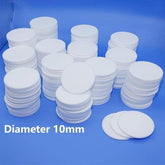Several cleaning methods of quartz cuvette
The quartz cuvette (alternatively referred to as the absorption cell or sample cell) serves the purpose of holding reference liquid or sample liquid, which is frequently equipped with various spectral analysis instruments, including a spectrophotometer, a blood line protein analyzer, and a particle size analyzer, to facilitate quantitative and qualitative analysis of substances. It is used extensively in a variety of industries and sectors, including chemical, metallurgy, medicine, pharmaceuticals, food, environmental protection, power plants, water treatment, petroleum, colleges and universities and scientific research testing. The quartz cuvette is generally characterized by a cuboid shape. The bottom and two sides are composed of ground glass, while the remaining two sides are characterized by an optical-transparent surface made of optical quartz glass. This is achieved through the integrated fusion process, glass powder sintering process at high temperature, and glue combination process.
 1. How to clean a quartz cuvette?
1. How to clean a quartz cuvette?
(1) In the event of the quartz cuvette being attached with colored substances, it is imperative that it is cleaned with a 1:2 molar solution of lithium chloride and ethanol, followed by washing with distilled water.
(2) For routine utilization, the quartz cuvette can be subjected to a direct wash with clean water, followed by a subsequent wash with pure water, and finally dried using a ventilator or by natural air circulation.
 (3) In order to remove any residual oil, it is recommended that the quartz cuvette be immersed in a 5% NaOH solution, followed by rinsing with distilled water.
(3) In order to remove any residual oil, it is recommended that the quartz cuvette be immersed in a 5% NaOH solution, followed by rinsing with distilled water.
(4) In the event of the quartz cuvette becoming excessively soiled, it is possible to cleanse it with specialist detergents, although these should be applied for a brief period (a few seconds) and the cuvette should then be rinsed with a large quantity of water. It is imperative to refrain from the use of detergents such as dish soap, as this may result in erroneous measurements.
 2. The following points should be noted when using cuvettes
2. The following points should be noted when using cuvettes
(1) When handling the quartz cuvette, ensure that only the ground glass surfaces are touched with your fingers, taking care to avoid contact with the optical surface. Simultaneously, exercise caution to prevent any external forces that could potentially damage the cuvette.
(2) Solutions containing substances that can corrode glass should not be stored in the cuvette for extended periods of time.
(3) It is important to note that the cuvette must not be heated over a flame or in an electric oven, nor can it be baked in a drying oven.
 (4) In the event of contamination of the cuvette, it is imperative that it is cleaned with anhydrous ethanol and wiped clean in a timely manner.
(4) In the event of contamination of the cuvette, it is imperative that it is cleaned with anhydrous ethanol and wiped clean in a timely manner.
(5) Please note that the transparent surface of the cuvette must not be contacted with hard or dirty objects. When containing the solution, the height should be 2/3 of the cuvette. If there is any residual liquid on the optical surface, it should be gently adsorbed with filter paper, and then wiped with lens paper or silk.






